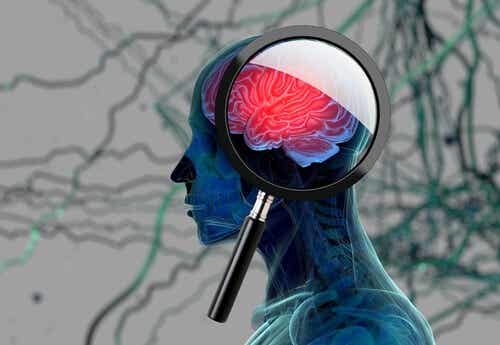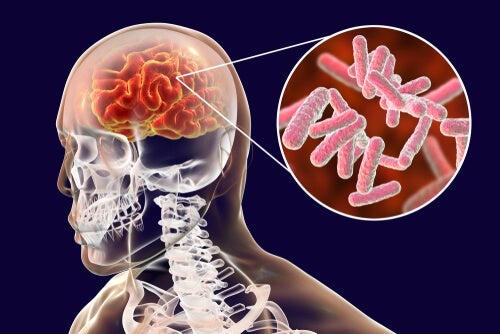People don’t usually think of brain infections when they think of infectious agents. It’s easy to imagine it in any other part of the body, though. But before we delve deeper into this, let’s say that an infection is the invasion and proliferation of pathogens that can easily affect the nervous system.
An infection occurs when a disease-producing microorganism invades the body. The main infectious agents are viruses, bacteria, fungi, and parasites. Brain infections usually originate from an external source, such as the ears, nose, or throat (among others).
“There’s hope, even when your brain tells you there isn’t.”
-John Green-
Types of brain infections
Depending on the affected area, the infection may be meningitis, which only affects the meninges, or encephalitis if it affects the rest of the brain. Meningeal infections cause confusion, fever, nausea, stiff neck, headache, and photophobia.
Encephalitis, in turn, causes the same symptoms as meningitis and many others depending on the affected nerve area. Finally, one can classify infections into viral, bacterial, fungal, and parasitic.
Viral infections
Neurotropic viruses have a special affinity for the nervous system, especially those that cause rabies and poliomyelitis. The susceptibility of the nervous system to them depends on the presence of specific membrane receptors.
A virus is an aggregate encapsulated in nucleic acid. It can lead to encephalitis or meningitis, depending on where it lodges.
Bacterial infections
This is one of the most aggressive brain infections. Bacteria are single-cell microorganisms that mainly produce meningitis. This disease can lead to pussy brain abscesses and cell death in the affected region.
Fungal infections
These are due to a fungus that penetrates the nervous system. The human nervous system is usually protected against these threats. However, an illness may decrease them and pave the way for them to thrive.
Parasitic infections
Parasites are organisms that live at the expense of another (a host). They may derive from an infection elsewhere in the body and usually manifest with symptoms of fever, malaise, and hypotension. Malaria, amoebae, and cysticercus are clear examples.
Diagnosis
As we mentioned above, most nervous system infections are secondary to infections in other parts of the body. The most common symptoms are:
- Headache.
- Fever.
- Vertigo.
- Nausea.
- Convulsions.
In addition, symptoms vary at the neuropsychological level according to the type of infection and the area of the nervous system they affect. Generally, the following neuropsychological symptoms might be present:
- Acute confusional syndrome.
- Temporal-spatial disorientation.
- Attentional defects.
- Memory failure.
- Motor agitation.
Detection mechanisms
Early diagnosis is vital, as symptoms can escalate to brain damage in a rather short period of time. Therefore, the physician usually conducts an exploratory study based on the patient’s history and recent activity. They’ll use more specific methods later on, such as:
- Neurological examination. These tests evaluate sensory and motor functions: hearing, speech, coordination, or balance, among others. Strength and reflex tests are also essential to determine the origin of the symptoms.
- Laboratory tests. Urine and blood tests are usually the most common due to their effectiveness in detecting antibodies or foreign proteins. These components shouldn’t be present in a normal situation. Thus, their presence is a reaction of the body to an infectious invasion.
- Cerebrospinal fluid analysis. The fluid that surrounds and protects both the brain and the spinal cord is useful for detecting infections, chronic inflammation, and other diseases in general.
- Neuroimaging techniques. These techniques are useful for detecting signs of inflammation and hemorrhage in the brain. Some examples of it are computed tomography, magnetic resonance imaging, and an electroencephalogram.
Treatment of brain infections
This depends on the affected area and diagnosis. These diseases are difficult to treat and irreversible in most cases. Physicians usually allow symptoms to elapse and then apply standardized protocols according to the type of infection.
For example, when the infection is bacterial, they’ll apply appropriate antibiotics to reduce symptoms and try to regress the disease.

The most common infections
The two most common infections of the nervous system are meningitis and encephalitis. Moreover, the main symptom is a brain or spinal cord inflammation that causes fever, headache, convulsions, and even death.
- Meningitis. The meninges are the bony tissue membranes that surround the brain and spinal cord. Infection often begins bacterially or virally. Haemophilus meningitis is the most common and mainly affects young children. However, vaccination against this disease in the first years of life substantially decreases the risk of death.
- Encephalitis consists solely of inflammation of the brain, largely caused by bacteria or viruses. Moreover, it can be primary, due to direct viral infection, or secondary, due to previous complications. Finally, it’s focal when it’s specific to a given area and diffuse when it affects several.
The current status of brain infections
Given the incidence of nervous system infections in the general population, research mainly focuses on their prevention. This happens mainly through vaccines and rapid and effective action protocols.
Furthermore, current research focuses on faster and more specialized interventions for each type of infection. Hence, the most sensible recommendation is to consult a specialist whenever symptoms appear in order to rule out a possible infection.
The post The Classification of Brain Infections and Their Symptoms appeared first on Exploring your mind.


















Comments